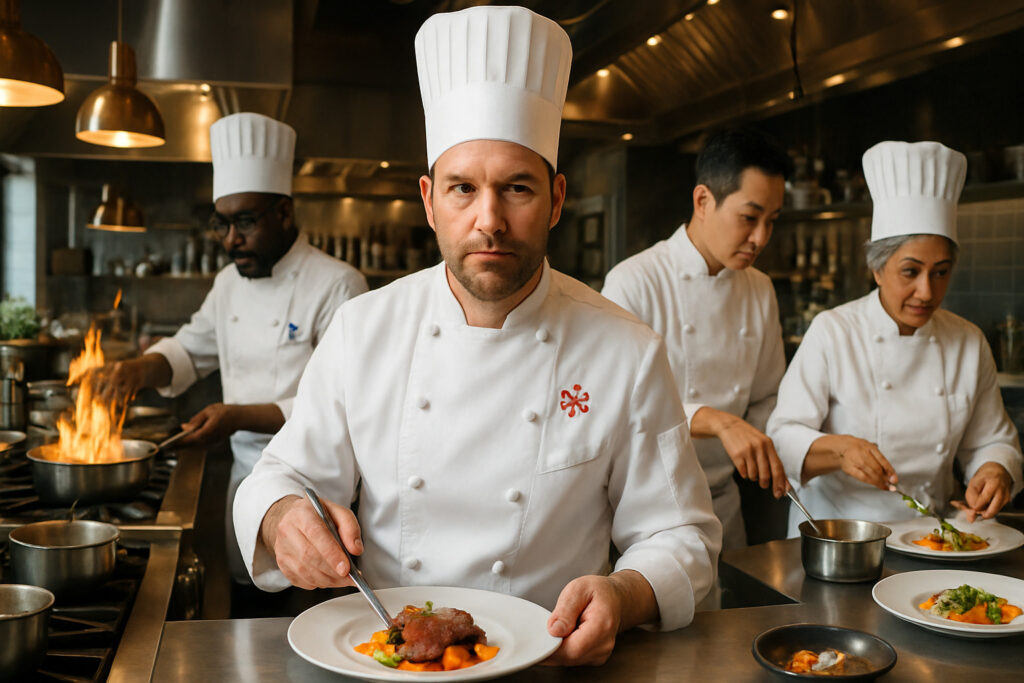Why Finding the World’s Best Chef Is More Complex Than You Think
The world’s best chef isn’t determined by a single ranking or award—it’s a complex ecosystem of Michelin stars, peer recognition, culinary innovation, and cultural impact that creates multiple champions across different criteria.
Quick Answer: Current Top Contenders for World’s Best Chef
- Most Michelin Stars (All-Time): Joël Robuchon (32 stars at peak)
- Current Star Leader: Alain Ducasse (21 stars across multiple restaurants)
- Most Famous Globally: Gordon Ramsay (17 total stars, massive media presence)
- Top Female Chef: Anne-Sophie Pic (10 Michelin stars)
- Rising Innovation Leader: Janaína Torres (World’s Best Female Chef 2024)
Here’s what makes this search fascinating: there’s no single “best” chef because excellence shows up differently across cultures, techniques, and dining experiences.
Joël Robuchon revolutionized French cuisine with his legendary potato purée using nearly equal parts butter and potato. Meanwhile, Janaína Torres democratizes fine dining at A Casa do Porco in São Paulo, offering world-class tasting menus for around $60 per person—proving that greatness doesn’t always come with three-star price tags.
The challenge for food lovers? Traditional rankings only tell part of the story. Michelin focuses heavily on European techniques. The World’s 50 Best celebrates innovation. James Beard honors American talent. Each system reveals different champions.
That’s why smart food travelers use multiple findy methods to find truly exceptional dining experiences—from decoding award patterns to tracking social impact initiatives that define tomorrow’s culinary leaders.
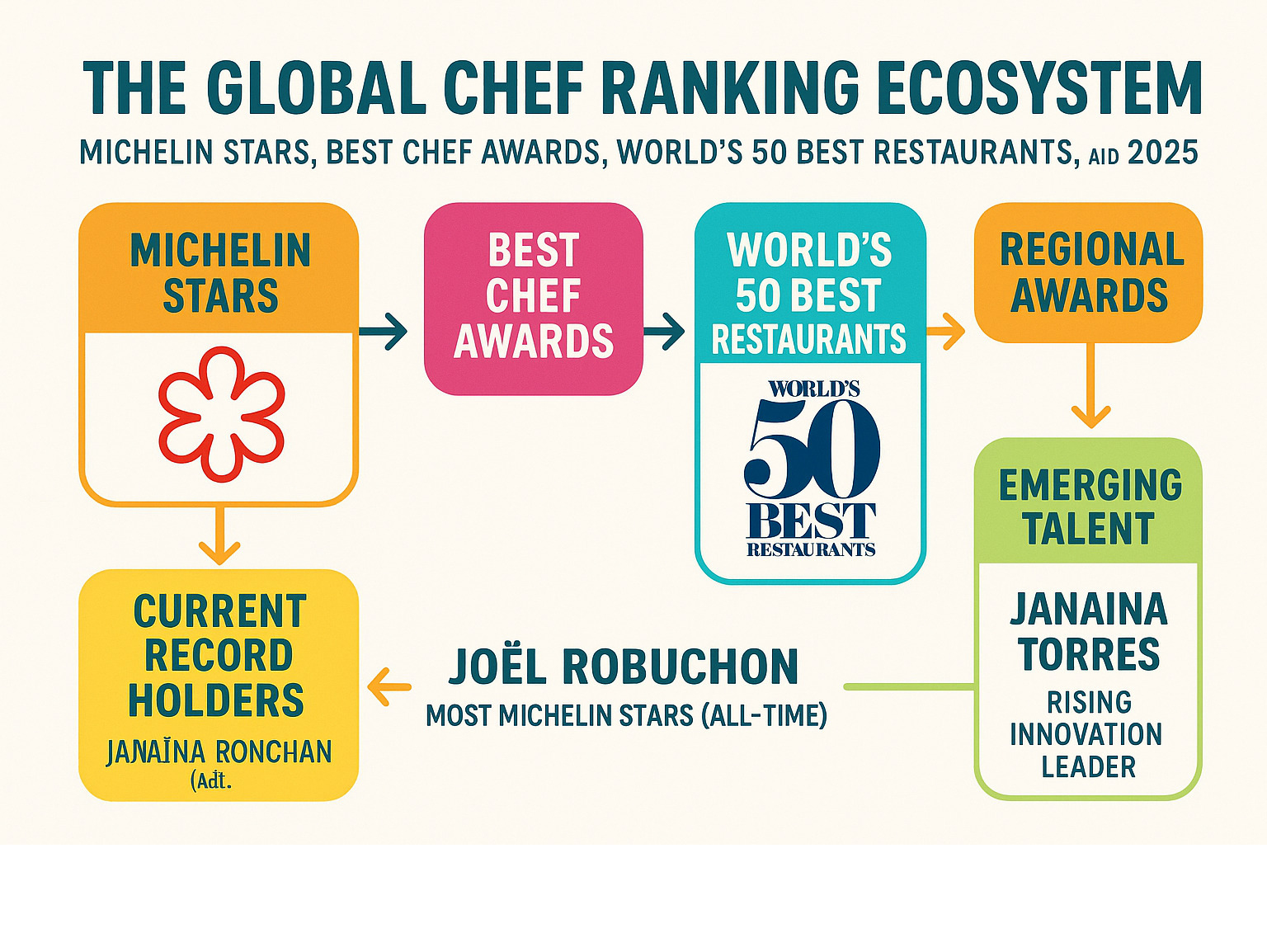
Essential world’s best chef terms:
1. Follow the Stars: Decode Michelin & Other Ratings
The Michelin Guide remains the gold standard for identifying the world’s best chef, but understanding how to read between the stars reveals far more than most diners realize. Think of it as a secret language that, once decoded, opens doors to extraordinary culinary experiences around the globe.
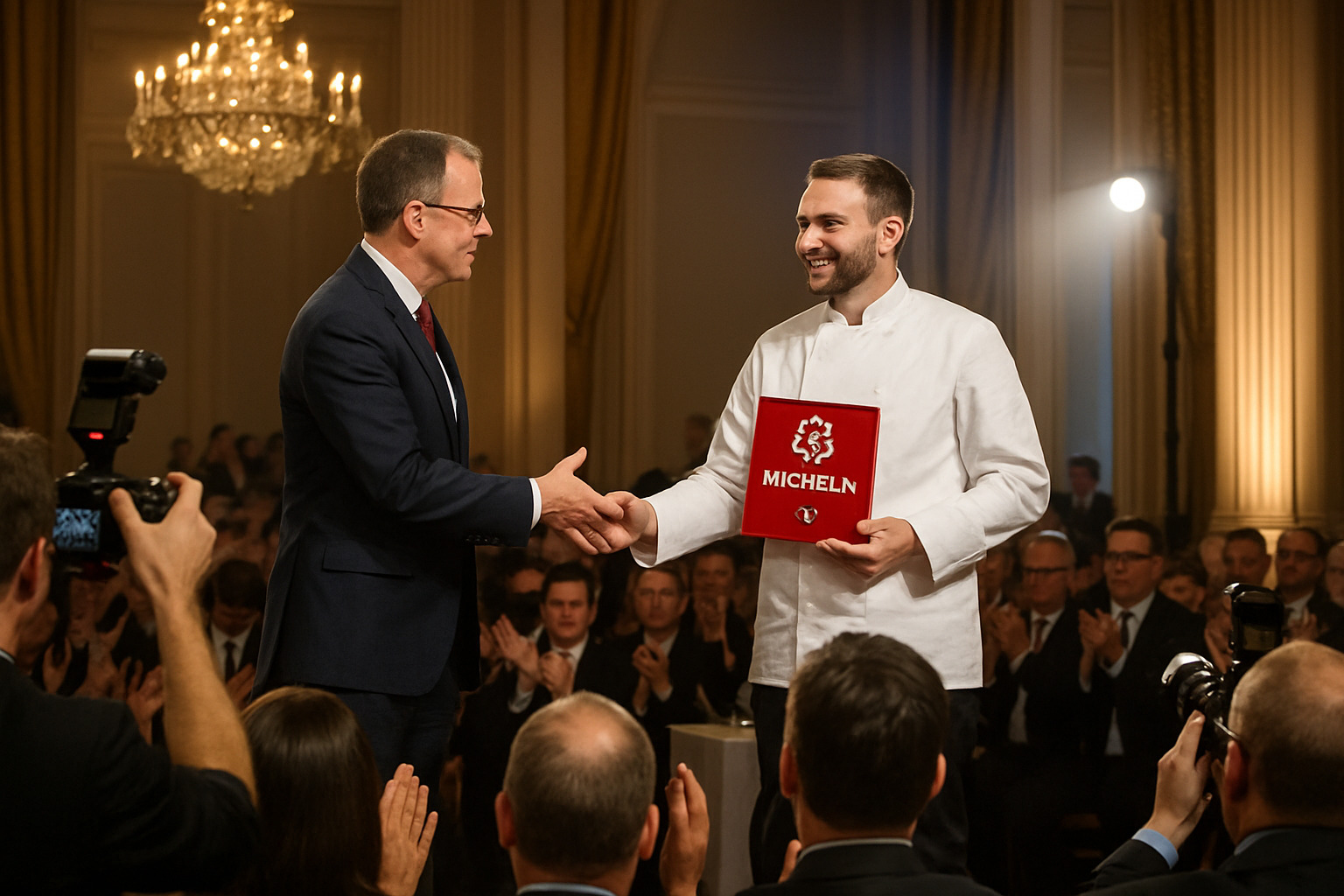
What Exactly Is a Michelin Star?
Here’s something that surprises many food lovers: Michelin stars are officially awarded to restaurants, not chefs—though the culinary world rightfully credits them to the executive chef leading the kitchen. It’s like giving an Oscar to a movie while everyone knows it’s really celebrating the director’s vision.
The star system works beautifully in its simplicity. One star means “very good restaurant” worth stopping for. Two stars signal “excellent cooking” that’s worth making a detour. Three stars represent “exceptional cuisine” worthy of planning an entire trip around.
The magic happens in the inspection process. Anonymous inspectors evaluate five specific criteria: ingredient quality, cooking technique, harmony of flavors, the chef’s personality in the cuisine, and consistency across the entire menu over time.
The rigor is almost obsessive. Inspectors visit multiple times, sometimes over several years, before awarding stars. They notice everything—from how precisely vegetables are cut to whether your bread arrives at the perfect temperature. This explains why earning just one star can transform a chef’s entire career overnight.
Why Star Counts Matter—but Aren’t Everything
The numbers behind Michelin stars tell fascinating stories about culinary greatness. Joël Robuchon holds the all-time record with 32 stars at his peak, earning him legendary status as a candidate for world’s best chef. Alain Ducasse currently leads with 21 stars spread across 36 restaurants worldwide—a feat that showcases not just cooking brilliance but incredible consistency across continents.
Gordon Ramsay has earned 17 total stars throughout his career, though he currently holds 8. Meanwhile, rising stars like Anne-Sophie Pic continue building their legacies with 10 stars and counting.
But here’s where it gets interesting: star counts don’t always reflect current excellence. Robuchon’s record includes stars from restaurants that have since closed. Ramsay actually lost 9 stars over the years due to restaurant closures and quality changes. It’s a reminder that culinary greatness requires constant dedication.
Geographic spread reveals another layer of achievement. Ducasse became the first chef to simultaneously hold three-star ratings in three different cities—Monaco, New York, and Paris. This global consistency arguably makes a stronger case for world’s best chef than pure numbers alone.
The system does have blind spots worth noting. Michelin only covers certain countries, meaning exceptional chefs in Southeast Asia, Africa, or South America often go unrecognized despite creating world-class cuisine. It’s why smart food travelers look beyond just Michelin when hunting for extraordinary dining experiences.
Understanding these nuances helps you spot true culinary excellence—whether it’s a three-star temple to gastronomy or a brilliant one-star gem that might just be tomorrow’s dining destination.
2. Track Global Chef Awards & Power Lists
While Michelin stars grab headlines, the real story of finding the world’s best chef unfolds across a fascinating network of international awards that each tell different parts of the culinary excellence puzzle. These competitions and rankings often spotlight extraordinary talent years before mainstream recognition arrives.
Think of it this way: if Michelin is like the Academy Awards of fine dining, then these other systems are the Cannes Film Festival, the Golden Globes, and the Critics’ Choice Awards all rolled into one. Each has its own personality and reveals different aspects of what makes a chef truly exceptional.
The Best Chef Awards takes a refreshingly global approach, recognizing over 160 chefs from more than 30 countries in their latest rankings. Their “Two Knives” designation goes to chefs scoring 40% or higher—essentially their version of world-class status. What makes this system special is how it celebrates excellence beyond traditional European fine dining, giving equal weight to a taco master in Mexico City and a pasta virtuoso in Rome.
The World’s 50 Best Restaurants operates through peer voting, where 1,080 industry experts and well-traveled food lovers cast ballots. This democratic approach often rewards innovation over tradition. Remember when Gaggan Anand’s progressive Indian restaurant in Bangkok held Asia’s top spot for three straight years? That happened despite having no Michelin stars at the time—proving that sometimes the industry recognizes greatness before the guidebooks catch up.
The James Beard Awards focus on American culinary talent, while the Bocuse d’Or tests pure technical skills in a competition format that’s part Iron Chef, part Olympic Games. Meanwhile, The World’s Best Female Chef Award shines light on incredible talent that traditional systems sometimes overlook. When Janaína Torres won in 2024, it brought global attention to her democratic approach to fine dining—offering world-class tasting menus for around $60 at A Casa do Porco in São Paulo.
Hidden Data Points These Lists Reveal
Here’s what most diners miss: these awards reveal patterns that predict culinary stardom. The voting systems, judging criteria, and regional focus of each award create a complex map of excellence that goes far beyond simple rankings.
Anonymous panels and peer voting systems often highlight chefs who are pushing boundaries in ways that traditional inspection-based systems might miss. Innovation metrics matter here—a chef experimenting with fermentation techniques or revolutionizing plant-based fine dining might score high on creativity-focused lists while still building their technical credentials for Michelin recognition.
The geographic spread tells its own story too. While Michelin historically concentrated on Europe and select international markets, these broader award systems celebrate exceptional chefs from regions like Southeast Asia, South America, and Africa who create world-class cuisine outside traditional fine dining frameworks.
Spotting Tomorrow’s World’s Best Chef on Shortlists
Smart food travelers don’t just watch the winners—they study the shortlists and rising star categories. We’ve noticed a clear pattern: future culinary legends often appear on multiple award shortlists for two to three years before breaking into top positions.
Take Mauro Colagreco as a perfect example. His restaurant Mirazur steadily climbed The World’s 50 Best rankings for years, building recognition across multiple award systems before claiming the #1 spot in 2019 and eventually earning three Michelin stars. That trajectory from emerging talent to global recognition is remarkably consistent.
Pía León followed a similar path, appearing on various “rising star” lists before establishing herself as a major force in South American cuisine. Emerging talents like those currently gaining recognition across multiple award systems often represent the future of global dining.
The democratization of fine dining—led by chefs who offer exceptional experiences at accessible price points—suggests that tomorrow’s world’s best chef might be someone who’s redefining excellence itself, not just achieving it within traditional frameworks.
3. Taste the Signature Menus of the World’s Best Chef
The most direct way to evaluate any world’s best chef candidate is through their signature dishes and flagship restaurants. After dining at dozens of world-renowned establishments, we’ve finded that truly exceptional chefs don’t just serve food—they tell complete stories through their menus, and you can decode their culinary philosophy in just a few carefully crafted bites.
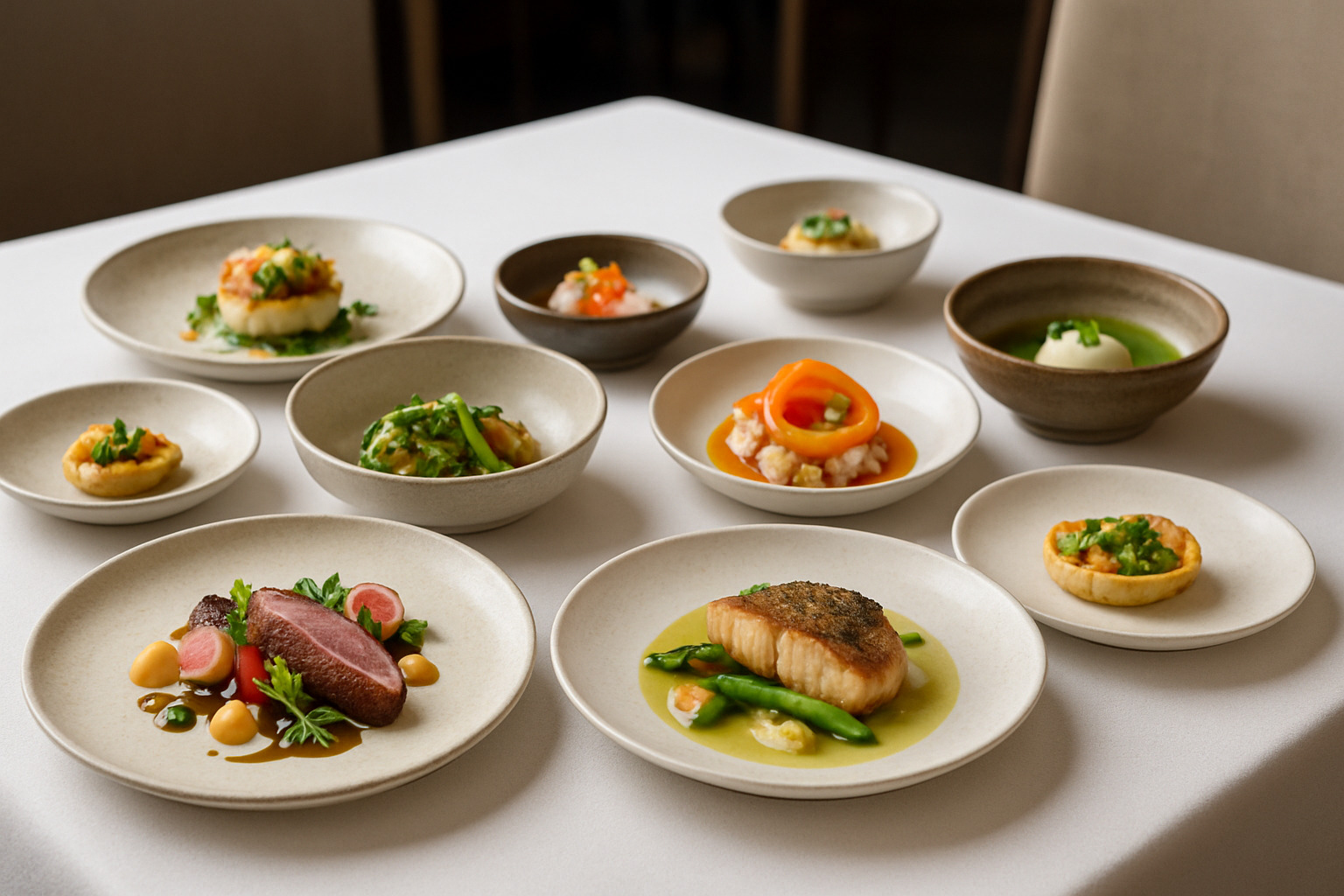
What makes flagship restaurants so revealing is how they showcase a chef’s complete vision. L’Atelier de Joël Robuchon revolutionized fine dining with its open kitchen concept, letting diners witness the precision that earned him 32 Michelin stars. Plaza Athénée under Alain Ducasse demonstrates his “naturalness” philosophy, focusing on vegetables, grains, and fish while eliminating meat from most dishes.
The French Laundry remains Thomas Keller’s masterpiece, where every detail—from the hand-picked garden herbs to the custom-designed plates—reflects his obsession with perfection. Meanwhile, Mirazur showcases Mauro Colagreco’s unique approach of cooking with ingredients harvested according to lunar cycles, creating a dining experience that changes with nature’s rhythms.
Perhaps most intriguingly, A Casa do Porco proves that the world’s best chef doesn’t always require luxury pricing. Janaína Torres offers world-class tasting menus for around $60, making exceptional cuisine accessible while maintaining the innovation and technique that earned global recognition.
How to Reserve at the World’s Best Chef’s Table
Securing a table at these legendary restaurants requires more strategy than luck, and we’ve learned the insider tricks that actually work. The key is understanding each restaurant’s unique booking system rather than relying on generic reservation platforms.
The French Laundry opens reservations exactly two months in advance at 10 AM Pacific Time. Set multiple alarms, have backup dates ready, and aim for the chef’s counter if possible—watching Keller’s team execute dishes with surgical precision is half the experience. Solo diners often have better luck with last-minute availability.
L’Atelier de Joël Robuchon locations worldwide maintain the master’s counter-seating philosophy, making reservations somewhat easier than traditional fine dining formats. The “workshop” kitchen concept means you’re part of the action, not just observing from afar.
Mirazur requires patience—this three-Michelin-star restaurant in Menton, France, books months ahead. Here’s a pro tip: call directly rather than using online systems. The staff sometimes accommodates last-minute cancellations, especially for solo diners or those willing to take early seating times.
The smartest approach? Many top chefs operate multiple restaurants at different price points. If the flagship is impossible to book, try their more casual concepts. You’ll often experience the same culinary philosophy and technique at a fraction of the cost and waiting time.
Decode a Signature Dish in Three Bites
Great chefs structure their signature dishes like musical compositions, with distinct movements that build toward a memorable crescendo. Understanding this structure helps you appreciate why certain dishes become legendary and separate the world’s best chef candidates from talented but ordinary cooks.
The first bite establishes identity—it’s the hook that tells you something extraordinary is happening. Robuchon’s famous potato purée achieves this through pure, concentrated flavor that’s immediately recognizable as transcendent, not just liftd comfort food. That first spoonful contains nearly equal parts butter and potato, creating a texture and richness that redefines your expectations.
The second bite reveals complexity and technique. This is where you find the layers of thought behind what seemed simple. In Ferran Adrià’s deconstructed dishes, the second bite often completely transforms your understanding of the first. What appeared to be one ingredient reveals itself as multiple components working in perfect harmony, each contributing to a larger story.
The third bite delivers the resolution—the moment that separates great chefs from merely good ones. Heston Blumenthal’s bacon-and-egg ice cream achieves this brilliantly, triggering childhood breakfast memories through unexpected textures and temperatures that shouldn’t work together but absolutely do.
Watch for texture contrasts (crispy meeting creamy, hot alongside cold), flavor evolution (how tastes develop and change as you chew), and emotional resonance (whether the dish surprises you or evokes specific memories). The true contenders for world’s best chef excel at orchestrating all three elements simultaneously, creating dishes that linger in your memory long after the meal ends.
4. Engage with Cutting-Edge Culinary Innovation Worldwide
The world’s best chef doesn’t just cook—they push boundaries and create entirely new ways of experiencing food. When you understand how culinary innovation works, you’ll spot tomorrow’s dining trends before they hit mainstream restaurants.
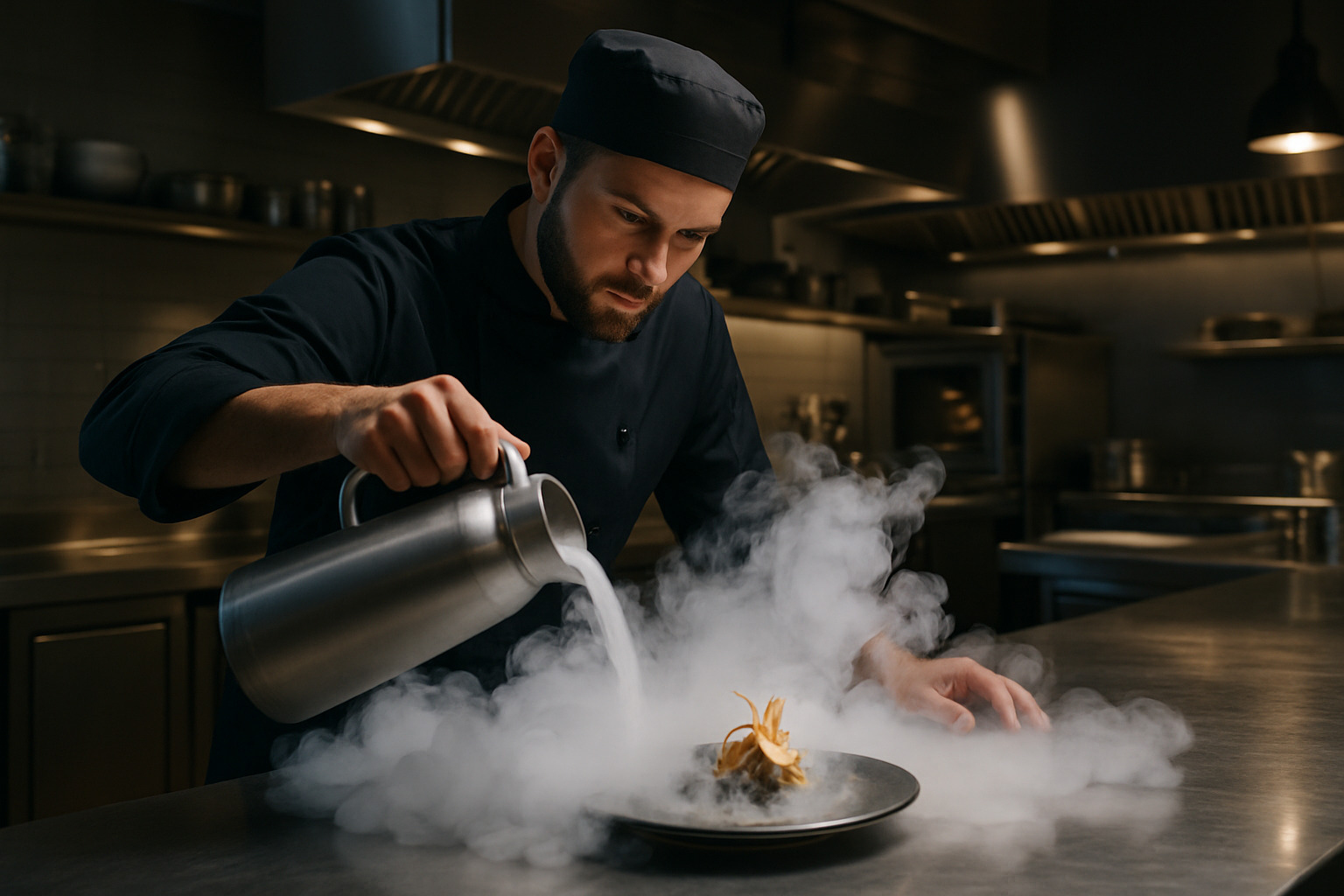
Think about Ferran Adrià at elBulli—he didn’t just serve dinner. He reimagined what dinner could be. His famous “deconstructed” dishes took familiar foods like tortilla española and transformed them into foams, gels, and textures that tasted exactly like the original but looked completely different. The genius? He preserved every flavor while creating something that had never existed before.
Heston Blumenthal takes this further by involving all your senses. His bacon-and-egg ice cream isn’t just a quirky dessert—it’s carefully engineered to trigger breakfast memories through temperature and texture contrasts. When you eat at The Fat Duck, dishes come with specific sounds played through headphones. It sounds gimmicky until you realize how much more intense flavors become when your brain is fully engaged.
René Redzepi revolutionized ingredients themselves through his New Nordic movement at Noma. Instead of importing expensive items, his team spends months foraging local plants and developing fermentation techniques that create entirely new flavor profiles. They’ve turned humble vegetables into umami-rich ingredients that rival aged cheeses or cured meats.
Pop-Up Labs & Masterclasses You Can Join
The exciting part? You don’t need a reservation at a three-star restaurant to experience world-class innovation. Many pioneering chefs now share their techniques through accessible formats.
Thomas Keller’s MasterClass gives you front-row access to The French Laundry’s precision-driven approach. While it’s online, Keller demonstrates why innovation often comes from perfecting fundamentals rather than chasing trends. His lesson on knife skills alone will change how you approach cooking at home.
Pop-up residencies offer another window into culinary creativity. When international chefs visit cities like New York, they often experiment with dishes that will never appear on their home restaurant menus. These events let you taste pure creativity without international travel costs.
Culinary workshops at cooking schools increasingly feature guest appearances by world-renowned chefs. You might find yourself learning fermentation techniques from a James Beard winner or understanding molecular gastronomy from someone who trained with Adrià himself.
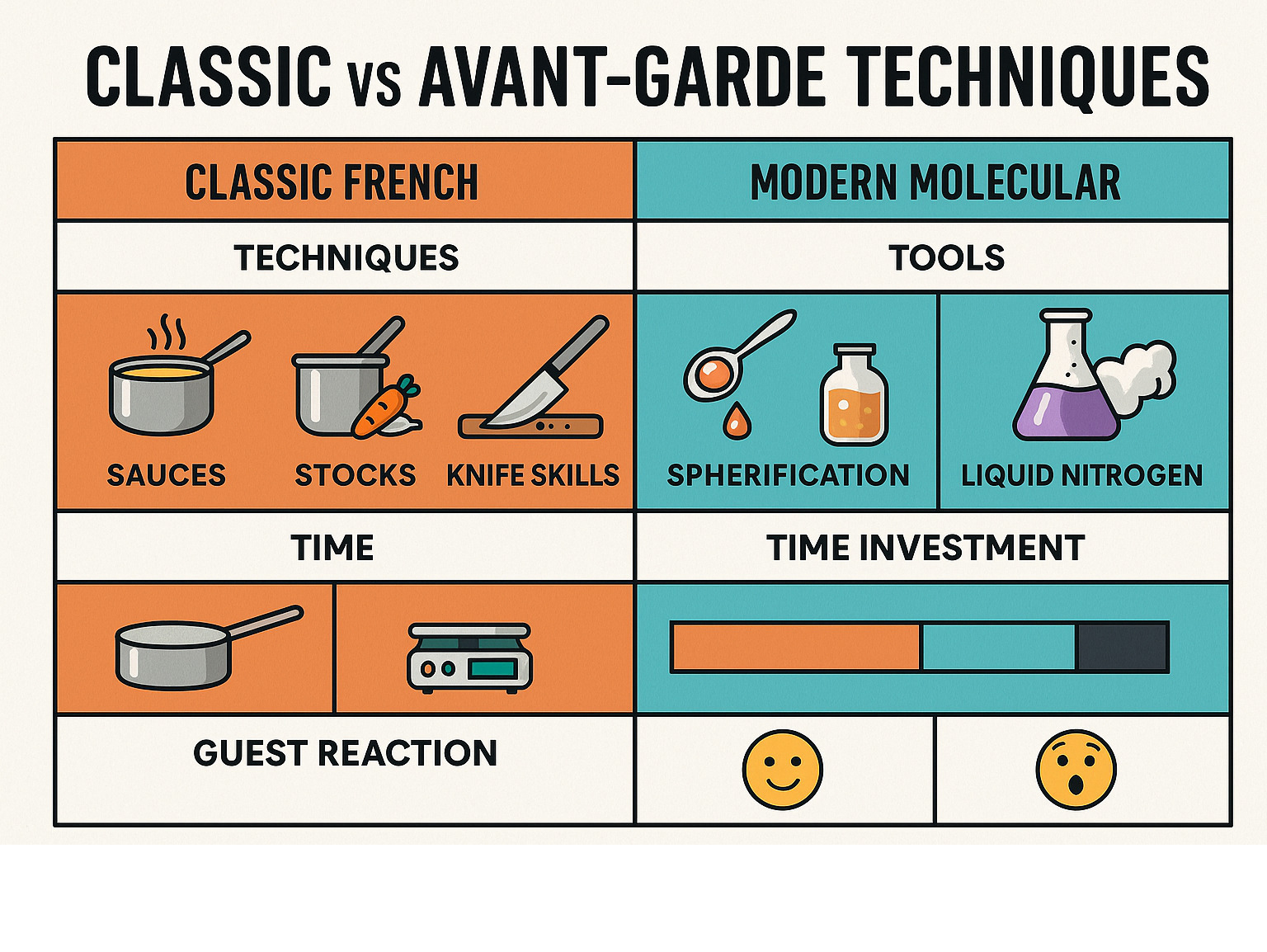
Comparing Classic vs. Avant-Garde Techniques
The most successful innovative chefs master both traditional and modern approaches. Classic French techniques focus on flavor harmony and perfect execution—think mother sauces, proper knife work, and understanding how heat transforms ingredients. Modern molecular methods emphasize surprise and sensory innovation using tools like liquid nitrogen and rotary evaporators.
Here’s what’s fascinating: the world’s best chef candidates don’t choose sides. Yannick Alléno earned 16 Michelin stars by first perfecting classical French cooking, then developed his patented “Extractions®” method to concentrate sauce flavors using modern equipment. His restaurants serve dishes that taste deeply familiar yet completely new.
The difference in guest experience is striking too. Classic techniques create comfort and familiarity—you know you’re eating something expertly prepared. Avant-garde methods generate surprise and conversation. Both approaches have their place, but the chefs who combine them create the most memorable dining experiences.
What we’ve learned from following culinary innovation worldwide is this: the best new techniques eventually become standard practice. Sous vide cooking was once cutting-edge molecular gastronomy. Now it’s common in mid-level restaurants. Fermentation was Redzepi’s signature innovation. Today, house-made fermented ingredients appear on menus everywhere.
This cycle means that staying connected to culinary laboratories and experimental kitchens gives you a preview of how all restaurants will evolve. The world’s best chef isn’t just cooking for today—they’re defining how we’ll all eat tomorrow.
5. Evaluate Social Impact, Story & Sustainability Scores
Today’s world’s best chef candidates increasingly distinguish themselves through social impact and sustainability initiatives. The culinary world has evolved beyond just creating exceptional dishes—modern chef excellence includes using their platform to create meaningful change in communities and food systems.
Why Purpose-Driven Cooking Defines the Next World’s Best Chef
The change is remarkable when you see how top chefs balance culinary excellence with social responsibility. Massimo Bottura runs his three-Michelin-starred Osteria Francescana while simultaneously operating Food for Soul, a nonprofit that turns surplus food into meals for vulnerable communities. During the pandemic, his organization recovered over 35 tons of surplus food in just one month—proving that world-class chefs can tackle both hunger and food waste simultaneously.
Mauro Colagreco took a different approach by becoming a UNESCO Goodwill Ambassador for biodiversity. His three-star Mirazur restaurant grows its own ingredients and works directly with local producers to minimize environmental impact. This isn’t just marketing—it’s a complete reimagining of how fine dining can support rather than exploit natural resources.
The influence extends beyond individual restaurants. Alice Waters pioneered the farm-to-table movement through her Edible Schoolyard Project, teaching thousands of children about sustainable agriculture and healthy eating. Her work at Chez Panisse shaped how an entire generation thinks about food sourcing and environmental responsibility.
Janaína Torres demonstrates that social impact can mean making excellence accessible. Her A Casa do Porco offers world-class cuisine at prices that democratize fine dining, while she simultaneously oversees nutrition programs for 1.8 million schoolchildren in São Paulo. She’s replacing processed ingredients with fresh, healthy options in school meals—showing how the world’s best chef can impact public health policy.
Yannick Alléno focuses on modernizing traditional French sauces through his patented Extractions® method, but he also emphasizes reducing food waste by using every part of ingredients in his sauce-making process. This technical innovation serves both culinary excellence and sustainability goals.
Simple Ways Diners Can Support These Causes
Supporting socially conscious chefs amplifies their impact in ways that extend far beyond your dining experience. When you choose restaurants with clear sustainability policies, you’re voting with your wallet for responsible practices. Many top chefs now display detailed information about their sourcing practices, waste reduction efforts, and community partnerships—look for these signs when making reservations.
Sharing their stories on social media creates ripple effects that surprise many diners. Chefs like Torres use their visibility to advocate for policy changes in school nutrition programs. Your posts help amplify their message to audiences they couldn’t reach alone.
Participating in special fundraising events lets you experience world-class cooking while supporting meaningful causes. Many celebrated chefs host charity dinners or cooking classes where proceeds support their nonprofit work. These events often feature exclusive dishes you won’t find on regular menus.
The most practical impact comes from learning their waste-reduction techniques for your own kitchen. During the pandemic, many top chefs shared tips for using vegetable scraps, proper food storage, and creative leftover changes. These skills save money while reducing your environmental footprint.
Award committees increasingly recognize this broader definition of excellence. The next world’s best chef will likely be someone who excels not just at cooking, but at using their platform to create positive change in food systems, communities, and environmental sustainability. It’s an exciting evolution that makes great dining experiences feel even more meaningful.
Frequently Asked Questions about Finding the World’s Best Chef
The quest to identify the world’s best chef raises questions that don’t have simple answers. After tracking culinary awards, dining at flagship restaurants, and analyzing global food trends, we’ve learned that the most common questions reveal fascinating insights about how culinary excellence actually works.
How is “world’s best chef” actually determined?
Here’s what surprises most food lovers: there’s no single authority crowning the world’s best chef. Instead, it’s like a complex puzzle with pieces from different award systems, each highlighting different aspects of culinary greatness.
Michelin stars focus on consistency and technical perfection. Their anonymous inspectors return multiple times over years, evaluating everything from knife precision to bread temperature. This system gave us legends like Joël Robuchon, whose 32-star record may never be broken.
The World’s 50 Best Restaurants operates through peer voting—1,080 industry experts worldwide choose their favorites. This system often rewards innovation over tradition, which is why Ferran Adrià’s elBulli dominated their rankings despite “only” having three Michelin stars.
Regional awards like James Beard celebrate local excellence, while The Best Chef Awards provides broader global representation. Each system reveals different champions because they value different things—technical skill, creativity, cultural impact, or pure innovation.
The definition keeps evolving too. Today’s world’s best chef candidates increasingly earn recognition for social impact and accessibility, not just luxury dining. Janaína Torres exemplifies this shift, earning global acclaim while serving world-class tasting menus for around $60.
Who currently holds the most Michelin stars?
Alain Ducasse leads active chefs with an impressive 21 Michelin stars across his 36 restaurants worldwide. What makes his achievement remarkable isn’t just the number—it’s the geographic spread and consistency.
Ducasse was the first chef to simultaneously hold three-star ratings in three different cities: Monaco, New York, and Paris. That’s like winning Olympic gold in three different sports. It proves he can maintain world-class standards across different cultures, ingredients, and dining expectations.
The all-time record belongs to Joël Robuchon, who peaked at 32 stars (28 at his death in 2018). Robuchon revolutionized fine dining through his L’Atelier concept, making Michelin-starred cuisine more accessible with counter seating and smaller portions. His famous potato purée—using nearly equal parts butter and potato—remains legendary among chefs worldwide.
Other current leaders include Gordon Ramsay with 8 active stars from 17 total earned, and Yannick Alléno with 16 stars across 18 restaurants. These numbers fluctuate as restaurants open, close, or experience quality changes that affect their ratings.
Which female chefs are breaking records today?
Anne-Sophie Pic leads female chefs with 10 Michelin stars, making her the most decorated woman in the Michelin system. Her story is particularly inspiring—she restored her family’s restaurant Maison Pic to three-star status after it had lost its prestigious rating, proving her individual excellence beyond any inherited reputation.
Janaína Torres represents a completely different model of culinary excellence. Named World’s Best Female Chef 2024, she runs A Casa do Porco, which ranks #12 globally while offering tasting menus for around $60. Torres simultaneously oversees nutrition programs for 1.8 million schoolchildren in São Paulo, proving that the world’s best chef can combine exceptional cooking with massive social impact.
Elena Arzak continues her family’s innovative Basque cuisine legacy, while Dominique Crenn became the first female chef to earn three Michelin stars in the United States. Ana Roš, World’s Best Female Chef 2017, operates the two-Michelin-starred Hiša Franko in Slovenia, proving that excellence exists far beyond traditional culinary capitals.
What’s fascinating is how these women are redefining culinary greatness itself. They’re not just matching traditional fine dining standards—they’re expanding the definition to include innovation, accessibility, sustainability, and community impact. The World’s Best Female Chef Award, voted by those same 1,080 industry experts globally, increasingly recognizes chefs who excel at multiple dimensions of culinary leadership.
Conclusion
The journey to finding the world’s best chef reveals something beautiful about food culture: there isn’t just one answer, and that’s exactly what makes it so exciting. From Joël Robuchon’s legendary potato purée that redefined French technique to Janaína Torres serving world-class tasting menus for $60 in São Paulo, culinary greatness shows up in wonderfully unexpected ways.
What we’ve finded through exploring award systems, tasting signature dishes, and tracking innovation is that the most memorable dining experiences often come from chefs who master multiple dimensions of excellence. The world’s best chef might be someone with 21 Michelin stars like Alain Ducasse, or it could be an emerging talent using fermentation techniques to create entirely new flavor profiles.
The five approaches we’ve shared—decoding ratings, tracking global awards, experiencing flagship restaurants, engaging with culinary innovation, and evaluating social impact—work best when combined. Smart food travelers don’t just chase Michelin stars; they also seek out the James Beard winner experimenting with molecular gastronomy, the UNESCO ambassador pioneering sustainable sourcing, or the chef whose pop-up residency is creating buzz on social media.
Here’s what excites us most: tomorrow’s world’s best chef will likely be someone who thinks beyond the kitchen. They’ll tell compelling stories through their food, champion environmental sustainability, make exceptional cuisine more accessible, and use their platform to create positive change in their communities. The definition of culinary excellence keeps expanding, and that benefits everyone who loves great food.
The Dining Destination—your passport to every plate—believes every meal is an opportunity to find something extraordinary. Whether you’re finally booking that impossible reservation at The French Laundry or finding an incredible neighborhood gem that serves perfect rigatoni, the search for exceptional cuisine connects us to cultures, stories, and experiences that go far beyond what’s on the plate.
Ready to start your own culinary trip? More info about culinary journeys and begin exploring the extraordinary world of global cuisine, one unforgettable bite at a time.

